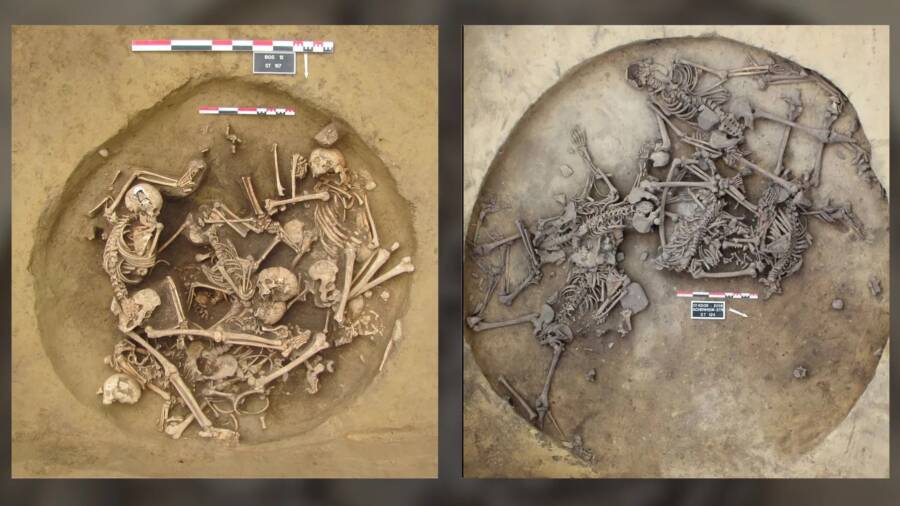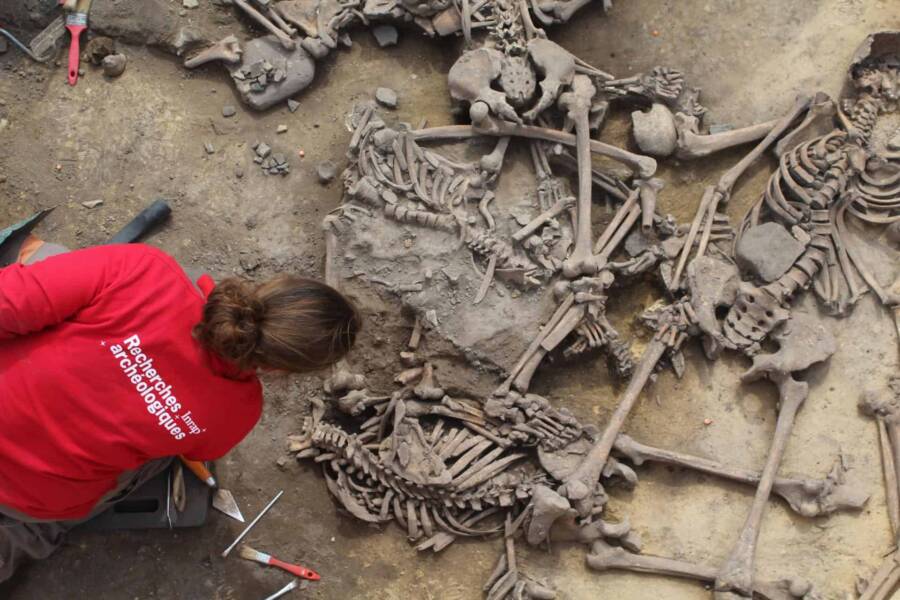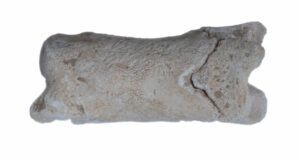Unveiled: Chilling Stone Age ‘Victory Pits’ in France Reveal Brutal Massacre Secrets
Ever wonder if our Stone Age ancestors threw victory parties? Well, turns out they did—only their version involved gruesome pits filled with not-so-happy guests. Dating back some 6,000 years, these eerie “victory pits” in northeastern France reveal a brutal side of ancient warfare that might make even the toughest reality TV seem tame. Imagine a public theater where enemies weren’t just defeated but displayed, mutilated, and celebrated in rituals that screamed dominance louder than any battle cry. These weren’t random acts of violence; they were carefully staged spectacles with severed arms as trophies—talk about a macabre souvenir! As we dig deeper into isotope analyses, we unravel a chilling narrative about outsiders, captives, and a community that didn’t just fight wars but turned them into horrifying pageants. Curious to step into this prehistoric drama? LEARN MORE.
The pits, which date back about 6,000 years, show the horrific reality of ancient warfare.

Fanny Chenal and Philippe Lefranc/INRAPTwo “victory pits” full of human skeletons excavated in northeastern France.
Archaeologists analyzing human remains from Stone Age sites in northeastern France have uncovered evidence of large-scale, ritualized violence dating back more than 6,000 years.
Using advanced isotope analyses, researchers traced the life histories of dozens of individuals whose bodies — or body parts — were deposited in pits at the Achenheim and Bergheim sites between 4300 and 4150 B.C.E. Their findings suggest these people were not victims of random massacres, but outsiders and enemies who had been captured, mutilated, and perhaps displayed in some of the earliest martial victory celebrations in Europe.
Shockingly, some of the remains showed signs of “unhealed trauma” and “overkill,” researchers noted in the Science Advances study, indicating the victors used far more force than necessary to kill the buried individuals.
Evidence Of Violence Beyond Necessity In The Stone Age “Victory Pits”
Excavations revealed a disturbing pattern. At the sites, skeletons bore multiple unhealed injuries, some inflicted after fatal blows — which likely points to deliberate mutilation rather than combat wounds alone.
The “lower limbs were [fractured] in order to prevent the victims from escaping, the entire body shows blunt force traumas and, what it is more, in some skeletons there are some marks — piercing holes — that may indicate that the bodies were placed on a structure for public exposure after being tortured and killed,” study author Teresa Fernández-Crespo told Live Science.
Alongside the bodies lay isolated left arms that had been carefully severed off. These were not scattered remains of warfare; they were likely trophies, removed with intent and likely carried back from battlefields before being placed in pits. This unusual combination of whole bodies and severed limbs has no previously known occurrences in the European Neolithic record.
The team analyzed isotopic signatures in 82 humans, 53 animals, and 35 modern plant samples to gain a better understanding of what, exactly, happened at these sites thousands of years ago.
These analyses allowed researchers to reconstruct the diet, mobility, and geographic origins of the ancient people. By comparing “victims” (those showing violent trauma or atypical burial) with “non-victims” (individuals buried in a normal fashion), the researchers tracked down clues about their fates and the events that possibly led to their demises.
The results were unmistakable. The victims weren’t local to the region. Their diets likely included different protein sources, and the isotope analyses also suggested they grew up in diverse landscapes and moved around a lot more. In short, they were outsiders moving in on a new territory.
A Public Theater Of Violence In Stone Age France

INRAPArchaeologists excavating one of the burial sites at the Stone Age pits.
Even within the victim group, there were some differences that emerged during the isotope analyses that suggested there could have been more than one group of invaders attacking the group that was local to the region. If that’s true, both invading groups were defeated by the local defenders — and then buried together.
One theory is that the arms may have been cut from fallen enemies on the battlefield and paraded as trophies, while the fuller skeletons could represent captives who were taken alive, tortured, and then executed in settlement centers. Alternatively, the severed limbs may have been the result of mutilations intended to cripple and humiliate captives.
“In this scenario, all victims would have been brought alive to the site as captives from different locations and then treated (or punished) differently for unknown reasons (e.g., their origins). Survivors of such mutilations (if any) may have been retained as slaves or even adopted, perhaps by families who lost many members during conflict,” researchers wrote.
Notably, the researchers argue these practices could have been carefully staged events, rather than spontaneous acts of cruelty. Killing and dismemberment likely took place in public, serving as a gruesome way to reinforce group identity and celebrate victory.















Post Comment